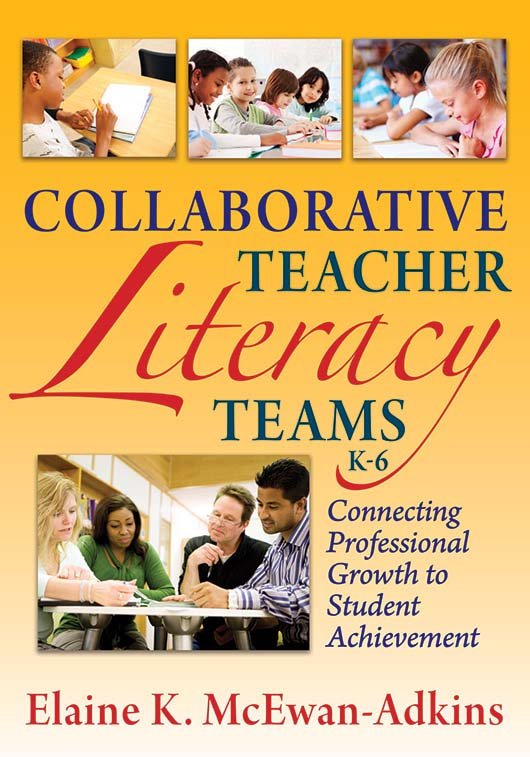Free Reproducibles
Collaborative Teacher Literacy Teams, K–6
Connecting Professional Growth to Student Achievement
With all the different components of literacy, planning and delivering effective literacy instruction can be overwhelming. Explore the work of collaborative literacy teams from their formation to the employment of successful student-focused strategies. Find professional growth units in each chapter that provide educators with the opportunity to discuss key concepts, self-reflect, and remain focused on student achievement.
Benefits
- Engage in deep discussion, reflection, and research-proven instructional techniques with team jumping-off points.
- Review literacy instruction exemplars to enhance understanding of best practices.
- Learn how to use educational tools including rubrics, graphic organizers, and goal charts.
- Explore 20 professional growth units, each including an Essential Question, Advance Organizer, Read to Understand and Remember, Cognitive Processing Activity, and Achievement Connection.
TABLE OF CONTENTS
Chapter 1: Instructional Moves
Chapter 2: Teacher-Managed Instruction
Chapter 3: Teacher With-It-Ness
Chapter 4: Student-Managed Learning
Chapter 5: Classroom Artifacts
Appendix A: The Exemplars and Nonexemplars of Effective K–6 Literacy Instruction
Appendix B: Table of Contents for the Twenty Units
PRINTABLE REPRODUCIBLES
- Figure I.2: Grade-Level Literacy Program Alignment Assessment
- Figure I.3: Sample Core Values
- Figure I.4: Definitions of Key Concepts
- Figure 1.4: Categorize to Summarize
- Figure 1.6: Unpack Your Backpack Organizer
- Figure 1.9: Who Is in the Zone?
- Figure 1.12: The Ratio of Affirmation and Praise to Corrective-Negative Feedback
- Figure 2.8: Lesson for Teaching the Meaning of Vocabulary
- Figure 2.10: Getting Ready to Design and Deliver Teacher-Managed Instruction
- Figure 2.12: Sentence Starters
- Figure 2.15: Team-Rating Scale for Teaching Discrete Skills
- Figure 2.16: The Important Organizer
- Figure 3.5: The Kind of Team We Want to Become
- Figure 3.15: Team Self-Rating Scale for Implementation of Organizational Routines
- Figure 3.16: Lesson Template for Teaching a Routine
- Figure 3.20: Categories of Students in Your Classroom
- Figure 4.4: Sentence Starters
- Figure 4.9: Applying the Key Concepts of Learning in My Life as a Learner and Teacher
- Figure 4.10: 4-Square Recall Question-Answer Form for Narrative Text
- Figure 4.11: 4-Square Recall Question-Answer Form for Short Nonfiction Articles
- Figure 4.12: 8-Square Cause-and-Effect Question-Answer Form
- Figure 4.13: 4-Square Compare-and-Contrast Question-Answer Form
- Figure 4.14: 4-Square Evaluation Question-Answer Form
- Figure 4.16: Ten Traits of Highly Successful Students
- Figure 4.17: Self-Rating Scale for Students in Grades 3–6
- Figure 5.10: Capture the Character Organizer
- Figure 5.11: Capture the Famous Person Organizer
- Figure 5.12: Picture the Plot Organizer
- Figure 5.13: Picture the Life of . . . Organizer
- Figure 5.14: Story Picture Gallery Organizer
- Figure 5.15: Biography Picture Gallery Organizer
- Figure 5.16: Somebody-Wanted-But-So-Then (SWBST) Organizer for Fiction
- Figure 5.17: Somebody’s Action/Attitude/Attribute Led To . . . (SALT) Organizer
- Figure 5.18: Menu of Actions/Attitudes/Attributes for Use With SALT Organizers
- Figure 5.19: Somebody’s Action/Attitude/Attribute Led To . . . (SALT) Organizer (Biography/Social Studies Text)
- Appendix A: The Exemplars and Nonexemplars of Effective K–6 Literacy Instruction
- Appendix B: Table of Contents for the Twenty Units

